
Western Mall
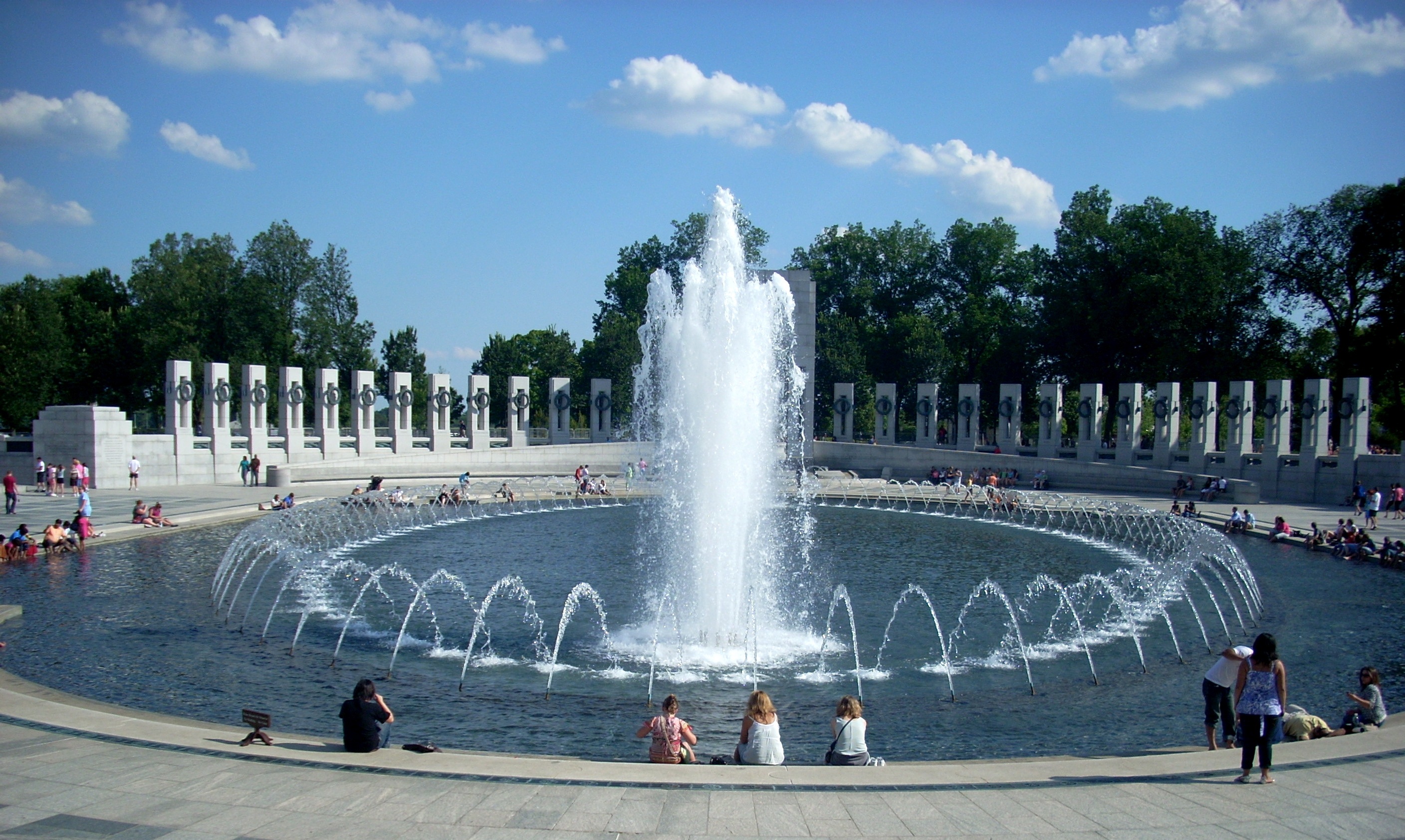
| Route 66 | Cities | Beaches |
 |
Western Mall |
 |
Getting There |
| No, when we're talking about this mall, we don't mean the nation's greatest shopping center. The National Mall is the term for the long strip of buildings and monuments stretching from The Capitol (Congress) on the East to The Lincoln Memorial on the West. The Western end of the Mall is the more open and scenic, with large expanses of grass, water and landscaping between the various attractions. You need one full day to see everything on The Western Mall, and then only if you've made arrangements ahead of time with your Congressman. We caution you, however : this is a demanding day, especially in the heat and humidity of Summer. Be sure to wear comfortable shoes, preferably hiking shoes with plenty of arch support. Carry water. Wear sunglasses and a hat. Dress in your most comfortable clothes. Bring extra film. And you may wish to bring fruit or other snacks to munch on during breaks. There are occasional carts selling beverages and snacks, but they are far between. It is VERY important that you start your day no later than 9 a.m., because most sites close at 5 pm, and you are in danger of running out of time. We review a counterclockwise tour here, but of course you could reverse the circle, or crisscross back and forth in random order. Indeed, you may HAVE to do that if the tickets you get from your Congressman dictate a particular time at, say, the White House or Washington Monument. One factor you must prepare for is the number of tour buses pulling up, unloading 60 passengers at a time, from every place in America plus every foreign country. On a typical day, expect 100,000 people on The Western Mall. That is not quite as bad as it sounds, since the huge area can swallow up that many, but it does mean you may be waiting in lines at some places, and when taking pictures you may have to wait while those ahead of you take their own and move out of your way. | 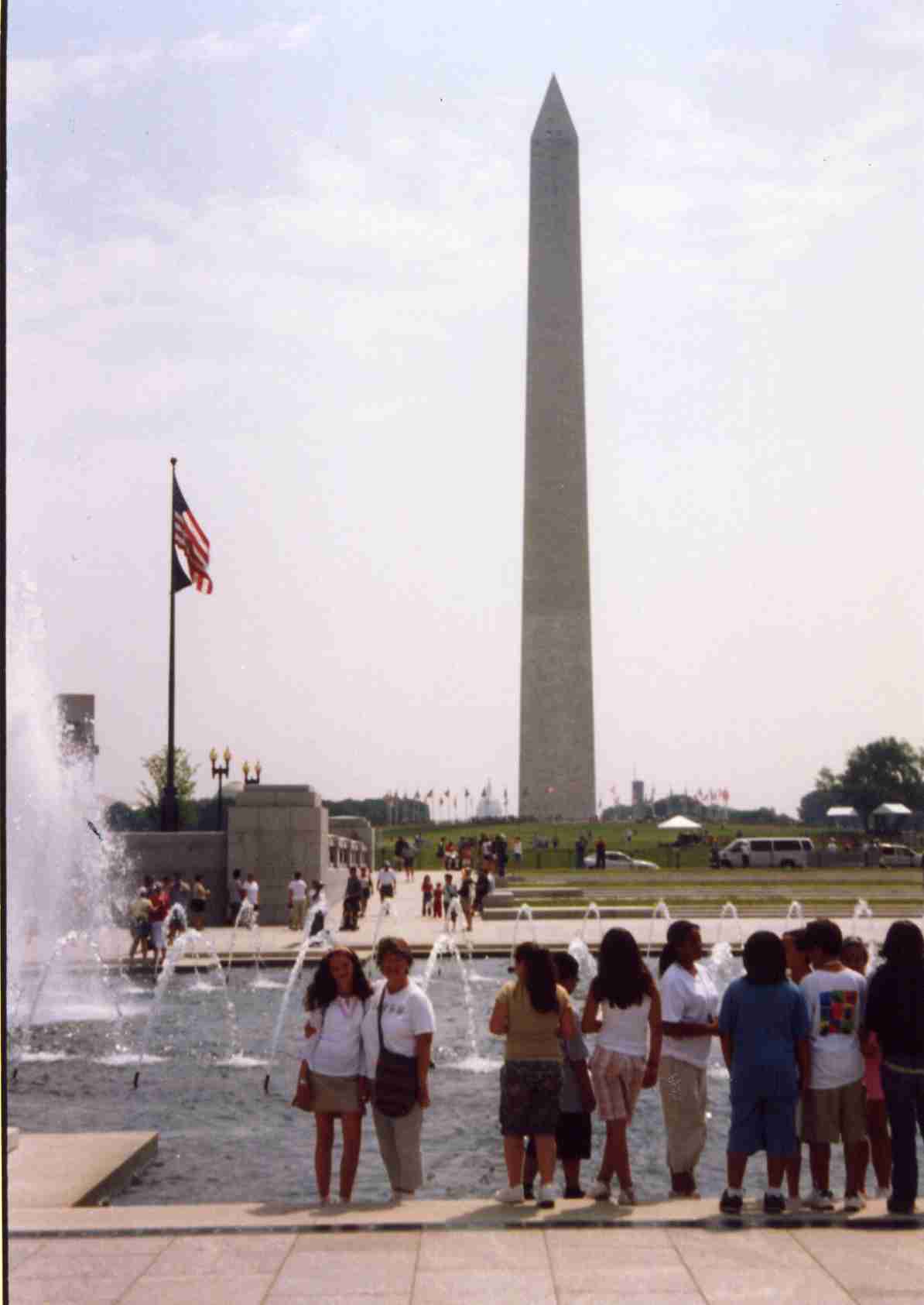 |
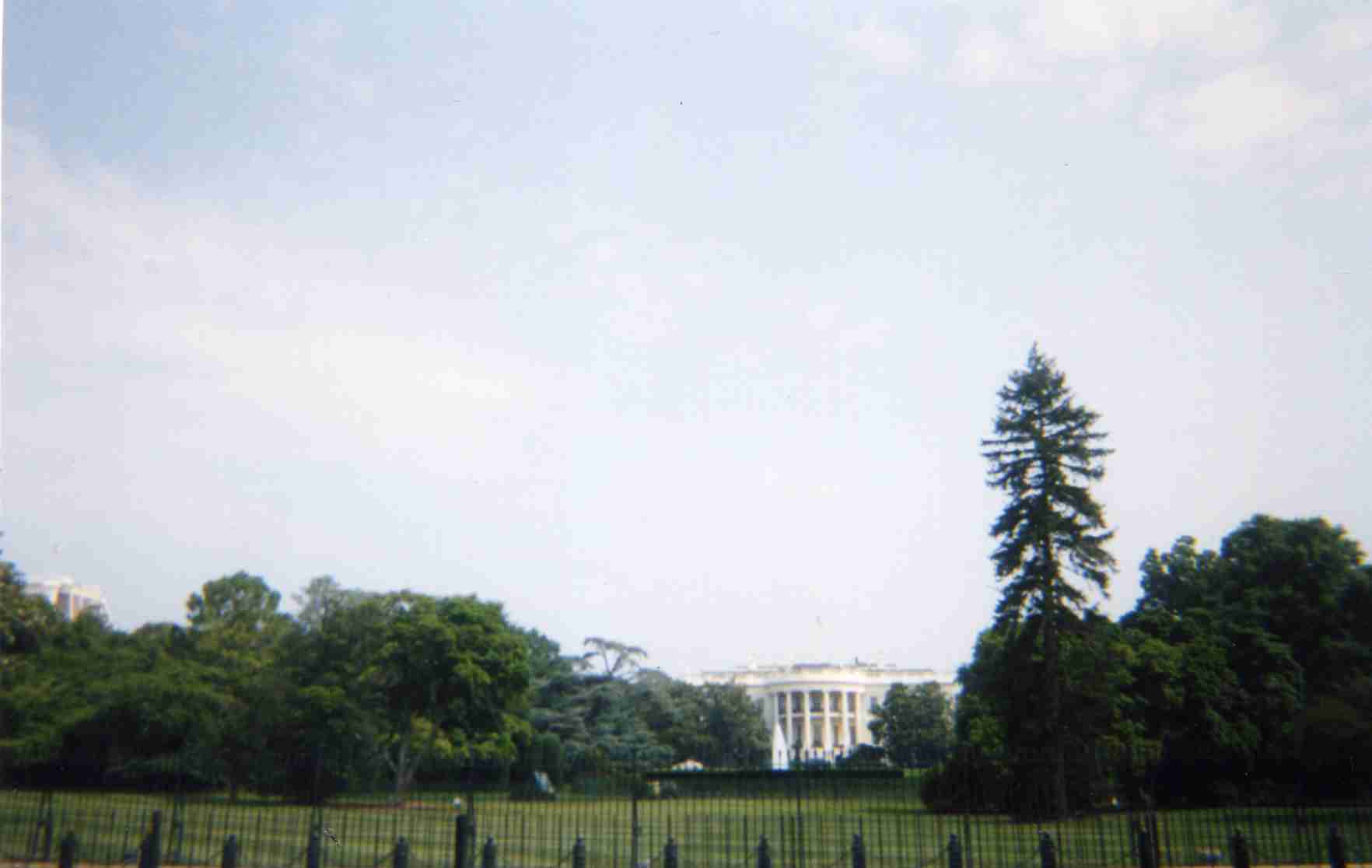 |
The White House is your first stop, if you can make arrangements for a tour with your Congressman a minimum of three months and preferably five months ahead. Since the Twin Towers event, security precautions have been greatly tightened. Even with tickets, a security alert can cancel your tour. They have also shortened the tour so you will not see quite as much of The White House as in the past. However, despite all these cautions, you should still make every effort to obtain one of the tour tickets, because the president's home is so beautiful and historic and you will treasure the experience all your life. The picture at left is taken from the security fence directly in front. Tours begin at a guard house on the right. You should report an hour early for orientation at the visitor center at 15th & E Streets. The tour itself lasts about an hour. You will be allowed photo privileges in some places. Tours begin Tuesdays through Saturdays from 7 am until 12:30. Leave your backpacks, bookbags and handbags at your hotel room, then go back for them after your tour (another reason to stay at The Harrington or another downtown hotel). The tours are free. There are restrooms in the visitor center. |
Second stop should be The Washington Monument. This is really in the front yard of The White House, except for the security fence shown above, and a long hill leading up to the base of the monument. This is a bigger structure than you realize. The flag plaza around the base (see photo at right) is quite a walk. The monument itself is 555 feet high, towering above everything else in the city. The view of the capitol building and the national mall from the top is one of the greatest sights in America. Tickets are free but a hassle to obtain. You need to wake up at 6 a.m. and send someone over to get in line at 7 a.m. at the Washington Monument Lodge on 15th Street (one more reason to stay at The Harrington or another downtown hotel). The ticket window opens at 8:30 a.m. The person you sent over can claim up to six tickets, and choose a time from whatever times are left when they reach the window. You can also get tickets in advance by phoning 1-800-967-2283, or going to http://reservations.nps.gov, but there is a $1.50 fee. We still like to go through your Congressman for these tickets. The elevator and a flight of stairs takes you to the top, where you have about 15 minutes to look and take pictures. You can see 30 miles in all directions. The monument was totally restored in 2000. It honors George Washington, but was not completed until 1884. The story of its construction is an adventure in itself, with financial dealing, political intrigue, delay during the Civll War, egos of architects and engineers, and several redesigns. Washington's remains actually rest at Mt. Vernon, half an hour South of this spot. |
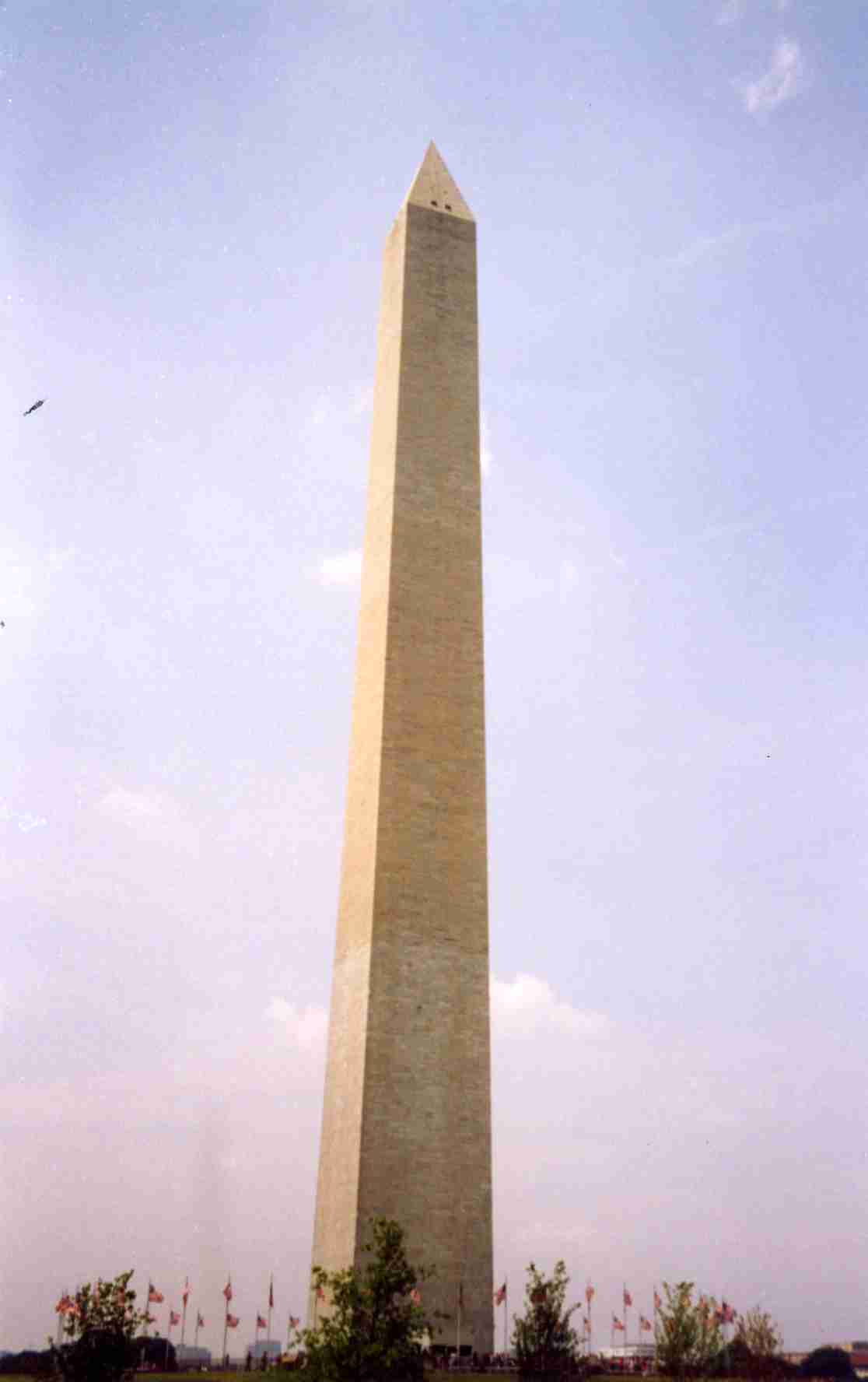 |
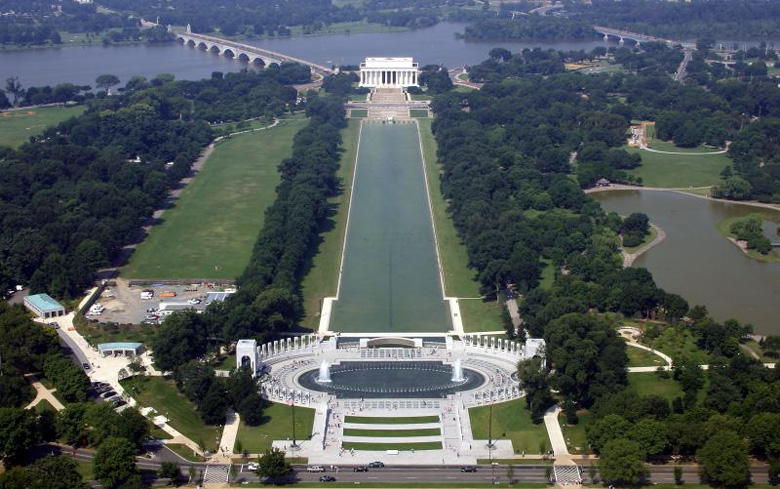 |
Leaving the Washington Monument, still heading West, the walkway brings you to the Reflecting Pool, shown here as seen from the top of the Washington Monument. The pool is 30 inches deep, 167 feet wide and 2029 feet long. At the close end is the World War II Memorial. To the right is Constitution Garden, which includes the irregularly shaped pond. To the left is a bus parking lot, rest rooms and a visitor center. Hidden by the trees at the far upper left is the Korean War Memorial. The Lincoln Memorial presides over it all from the hill at the far end. The Reflecting Pool and its adjacent features are much more impressive when you are walking among them than when looking down on them, as in this photo. |
| The World War II Memorial, also shown top of the page right, is one of the less talked about but most beautiful Mall sites. The bubbling cool water is especially attractive on hot days, when thousands of visitors stop to dip their feet or wade in briefly. Sitting here, one has clear views one direction along the reflecting pool to the Lincoln Monument and the other direction to the Washington Monument and beyond to the Capitol Building. This same scene can also be seen from the top of the Washington Monument in the photo directly above. | 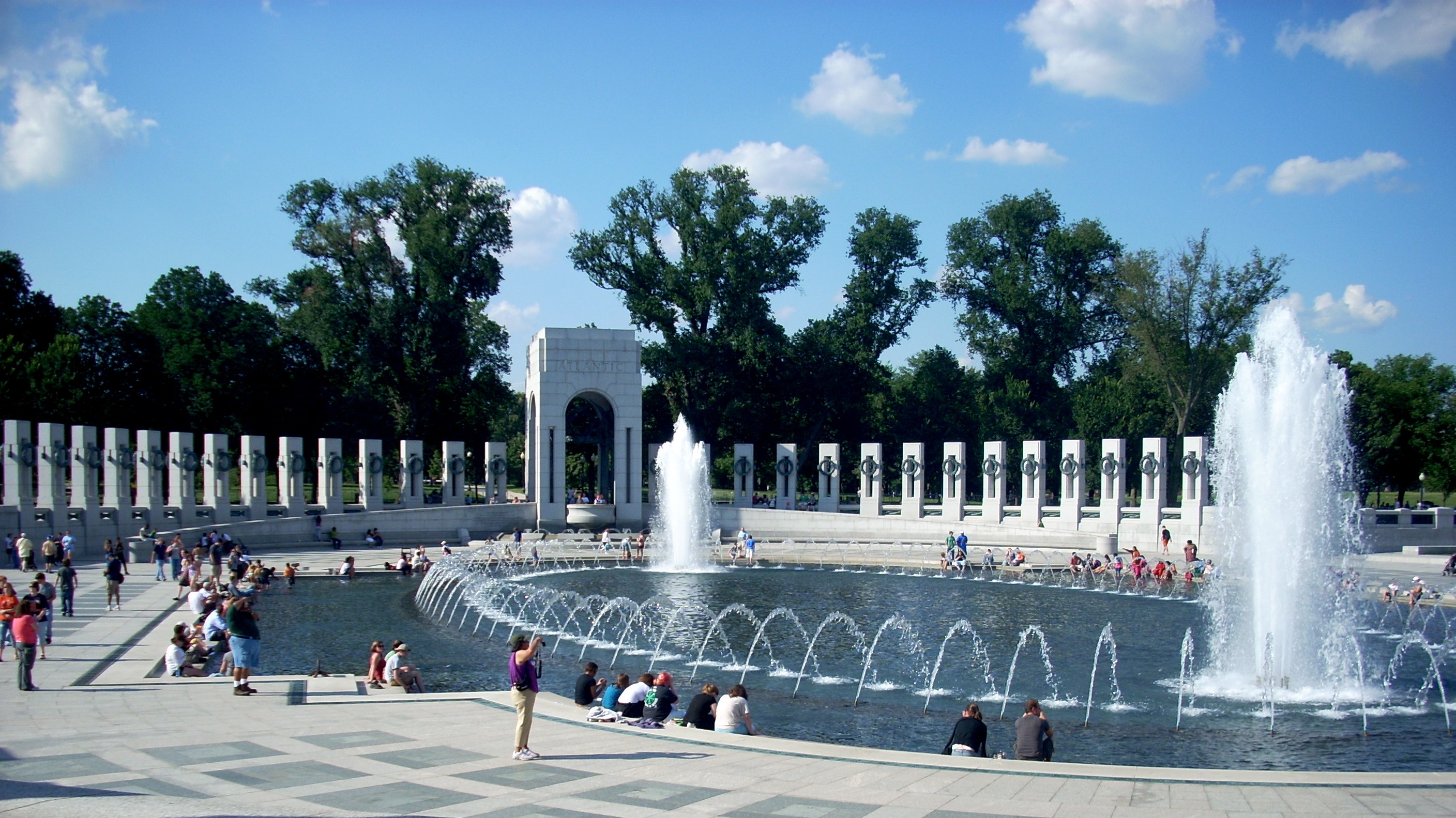 |
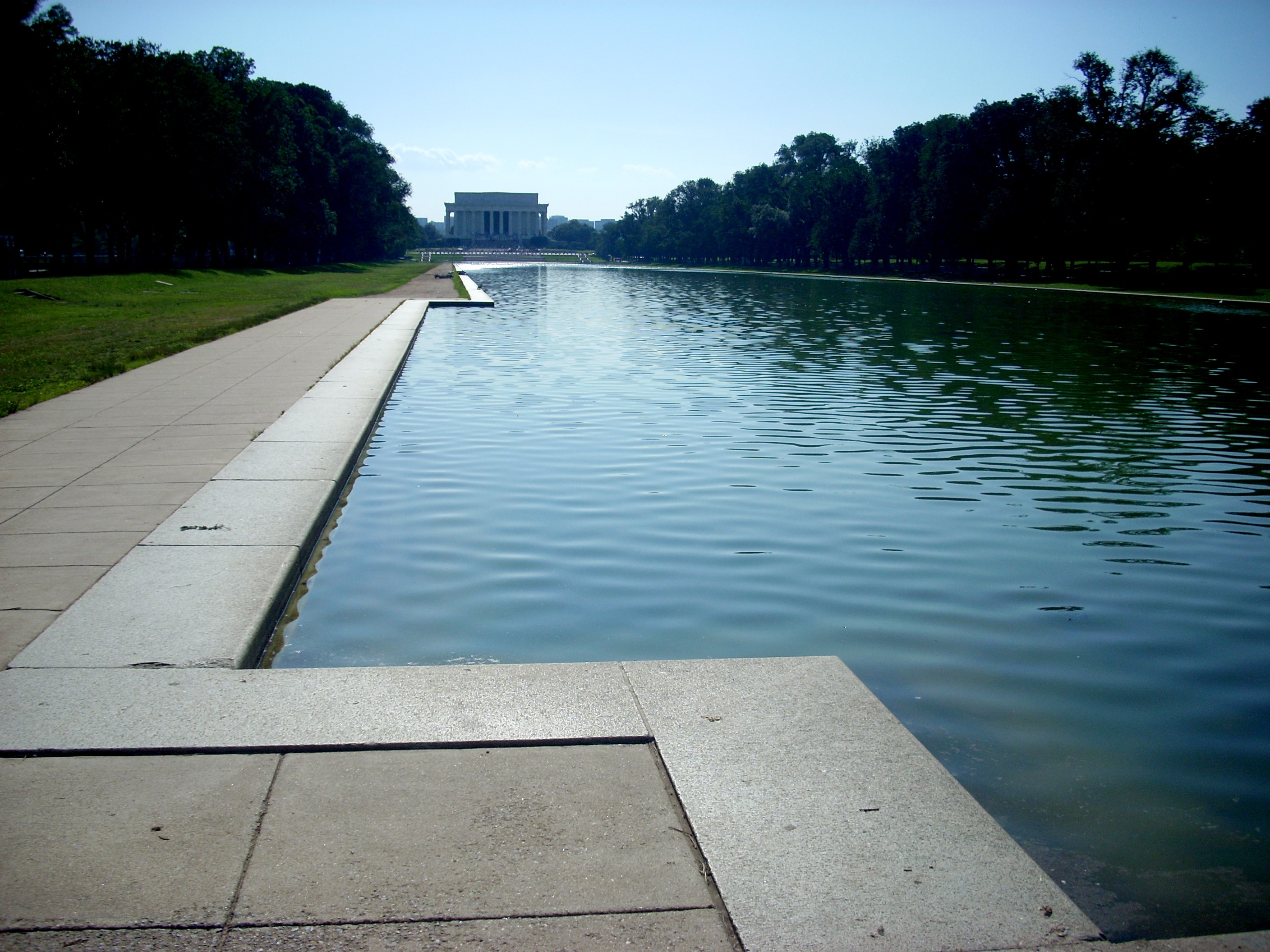 |
The Reflecting Pool is seen here looking West from the World War II Memorial toward the Lincoln Memorial. You could hike the entire distance along this walkway but most people walk on sidewalks over in the trees to the right or left. The space along here allows for future monuments to future national heroes. |
| Looking East along the reflecting pool toward the Washington Monument with the Capital Building below and behind it slightly to the right. This photo is taken from one of the lower steps of the Lincoln Memorial. The fence stretching across the pool is temporary as a crowd control device for the Fourth of July. This photo was taken July 5th and clean up was still in progress after the usual crowd of 100,000 descended on the Mall for the fireworks display. | 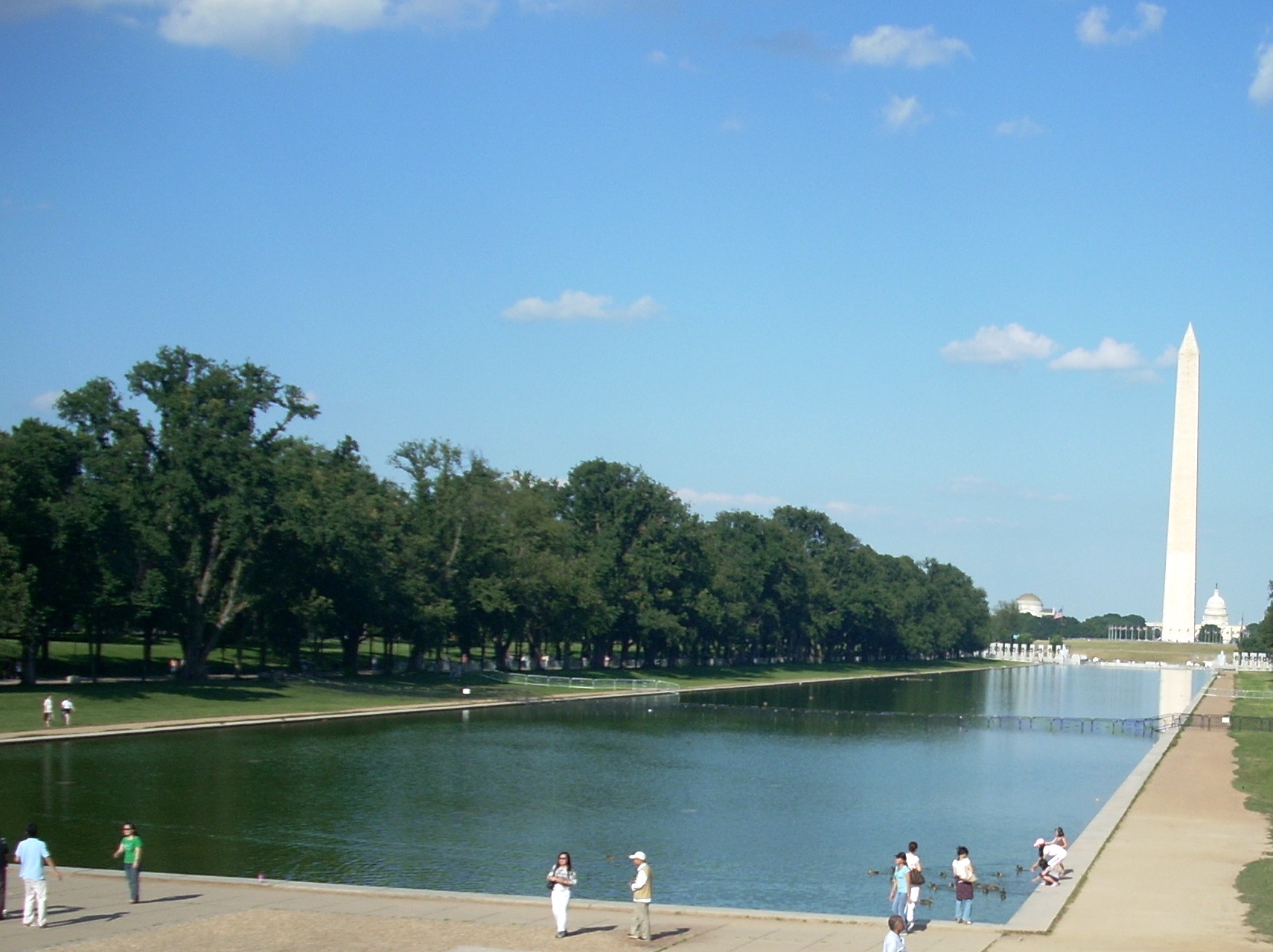 |
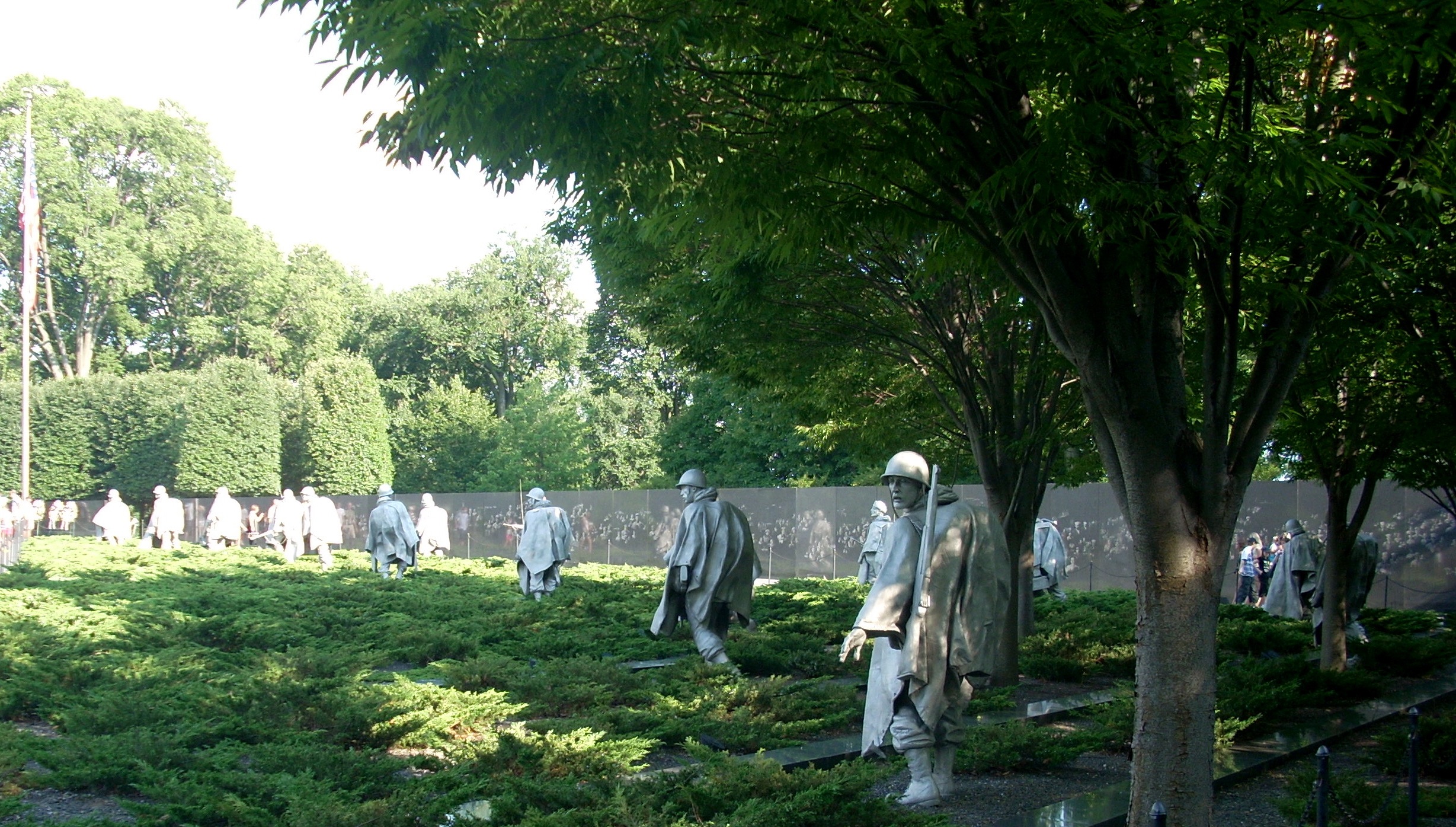 |
The Korean War Memorial occupies a clearing in the trees just below the Lincoln Memorial, visible at the right in the photo. The Korean Memorial is a haunting series of 19 stainless steel ghostlike sculptures, representing a troop out on patrol on a cold rainy day. The memorial was dedicated in 1995 and certain surrounding features added in 1999. These included a computer stand with all the records of every man who served there, special lighting, and a stand from which national park service guides could do their presentations. This photo is taken from the main sidewalk just as you enter the memorial, with the men walking away from you. In the background you can see the wall, which has the names of every American killed in Korea. |
| This photo is taken from the fountain at the front of the memorial with the men walking toward you. The wall is to your left, just out of this photo. The Lincoln Memorial is just visible over the trees to the right. If you are staying downtown, a special treat is to walk over and visit this memorial at night. Special flickering lights cause the 19 figures to appear as ghosts, emerging from the woods and the mists of the pond. The memorial honors those who served in the three year Korean War, 1950-53, as America turned back the Chinese Communists and North Koreans and guaranteed that South Korea would become a free democracy. This is not the biggest or most expensive monument in Washington, and no one man's name is on it, but it may be the most emotionally powerful. | 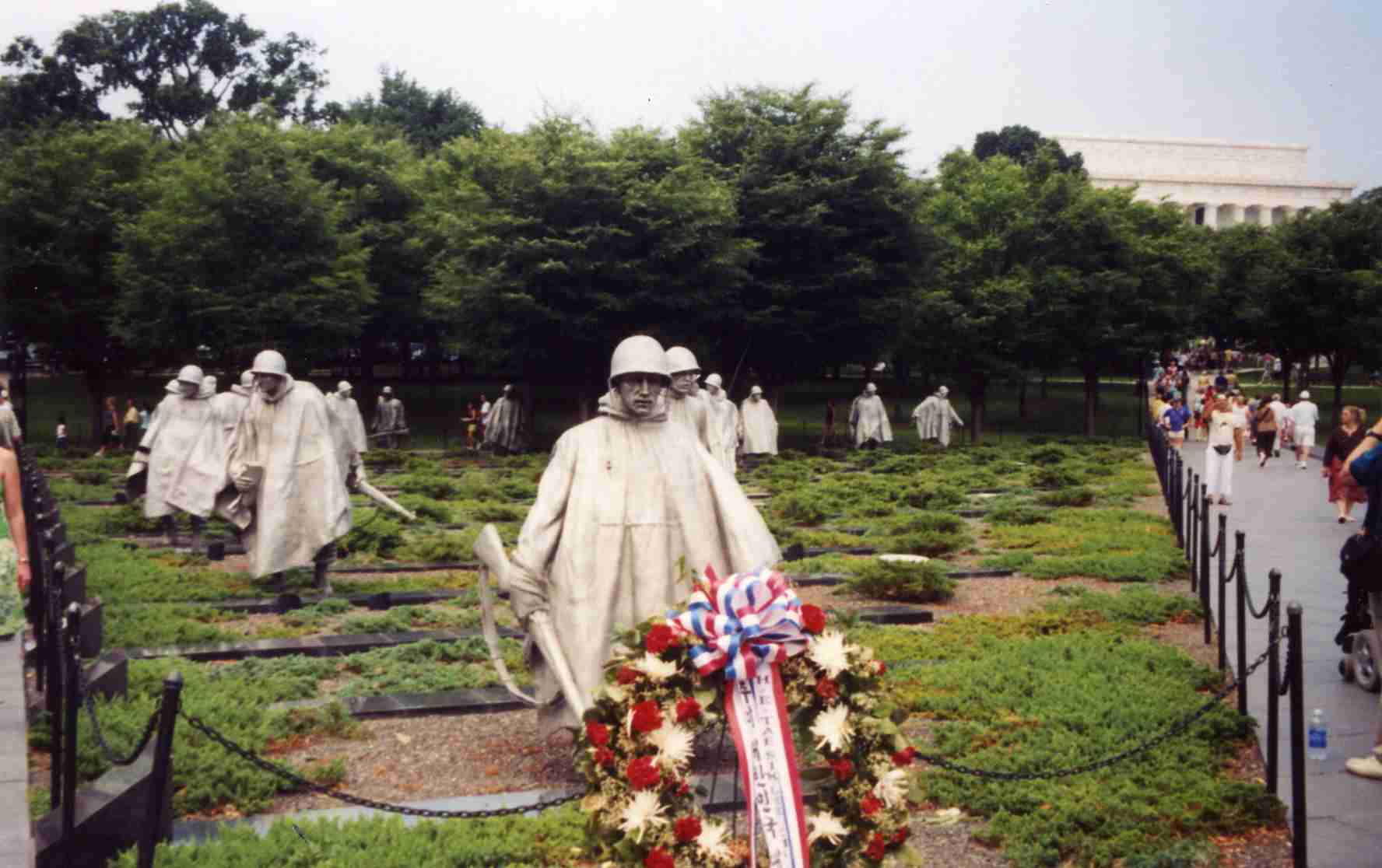 |
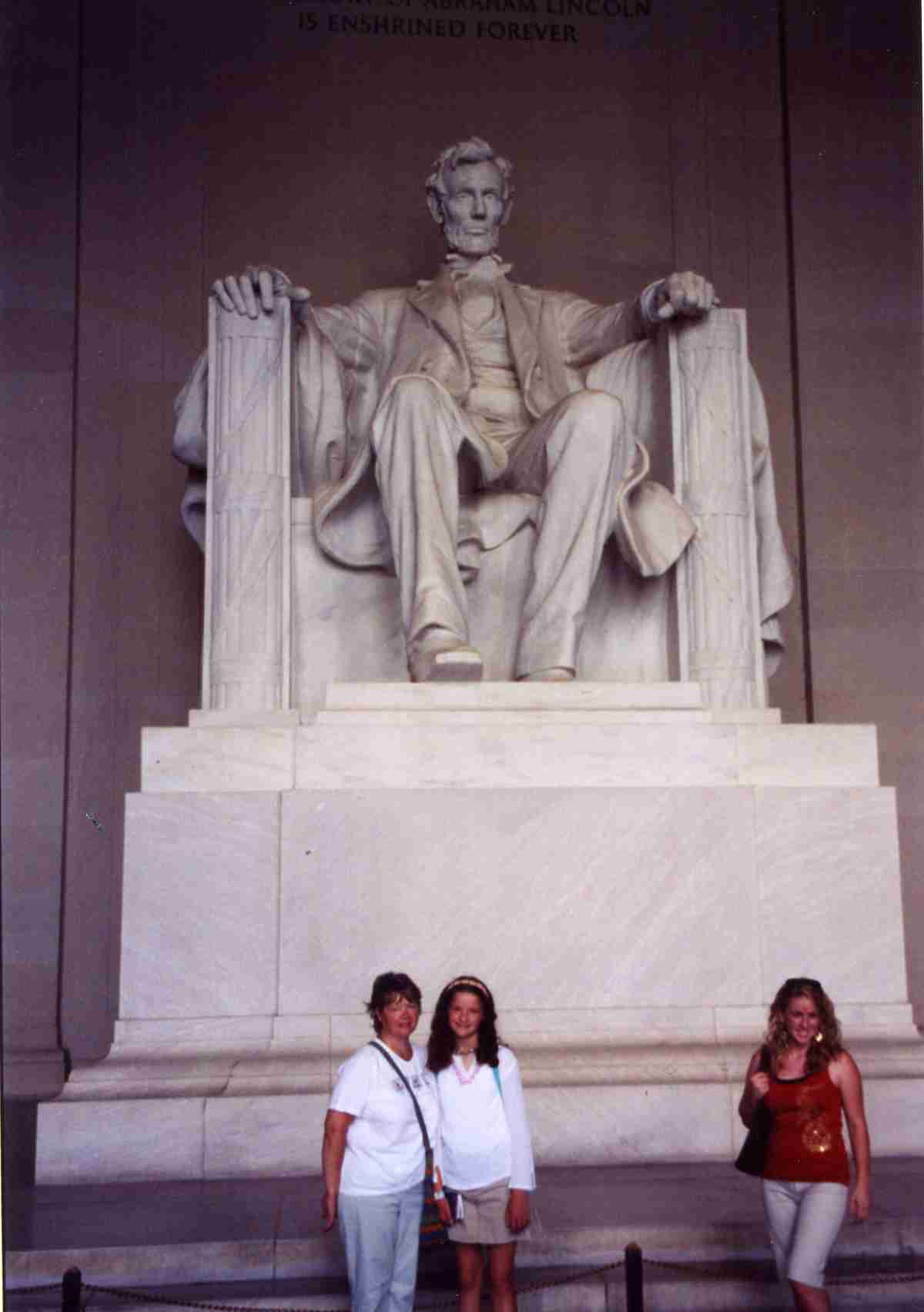 |
The Lincoln Memorial is probably the most famous and most photographed of all the sites in Washington. It sits high on its hill, up a very long flight of steps, looking back over the reflecting pool, Washington Monument, and beyond to the capitol building in the distance. The sheer size of the Lincoln Memorial is overwhelming. Everything about it is huge: the doors, the pedestal, and the features of the statue. Abraham Lincoln somehow seems to represent all that has been so good about America, rising from a log cabin, studying law books by firelight, overcoming health problems and an ungainly appearance to lead the nation through a civil war and deliver speeches that we still hold up 150 years later as rhetorical masterpieces. His tragic assassination only heightens his legend, as we feel he was taken from us before his work was completed, that if he had lived the horrors of Reconstruction would have been avoided. The Memorial was dedicated in 1922. The Doric temple is made of limestone and marble, with 36 columns each 37 feet high. The statue of Lincoln is 19 feet nine inches tall. His most famous speeches are displayed on the walls. Lincoln is also beloved by the American deaf community because he worked for and signed into law the creation of Gallaudet University, the college for the deaf. The sculptor had a deaf son, and in tribute to Lincoln's efforts, he has the president's hands forming the deaf symbols for A and L. The Lincoln Memorial over the years has become famous for other speeches and meetings. A tile marks the spot where Martin Luther King delivered his I Have A Dream speech to a crowd of 100,000. Richard Nixon met here at 3 a.m. with Vietnam War protestors the day after the Kent State massacre and calmed an explosive situation. If you stay downtown, the nighttime view of the specially lighted Lincoln Memorial is incredibly beautiful. |
| The Franklin Deleanor Roosevelt Memorial is the least known on the Mall. It is hidden in the trees on the shore of the Tidal Basin and many people walk past it between the Lincoln Memorial and Jefferson Memorial and pay no attention to the sign or the short walkway to the right. However, this is a beautifully designed and meticulously maintained memorial, a heavily shaded waterscape with boulders and terraces, pools and waterfalls. Plaques mounted on rocks review Roosevelt's legacy : Social Security, Medicare, World War II, the only president to serve three terms and the only one to govern from a wheelchair. Exactly halfway between the two most popular monuments, this makes a convenient resting stop for children or older folks. | 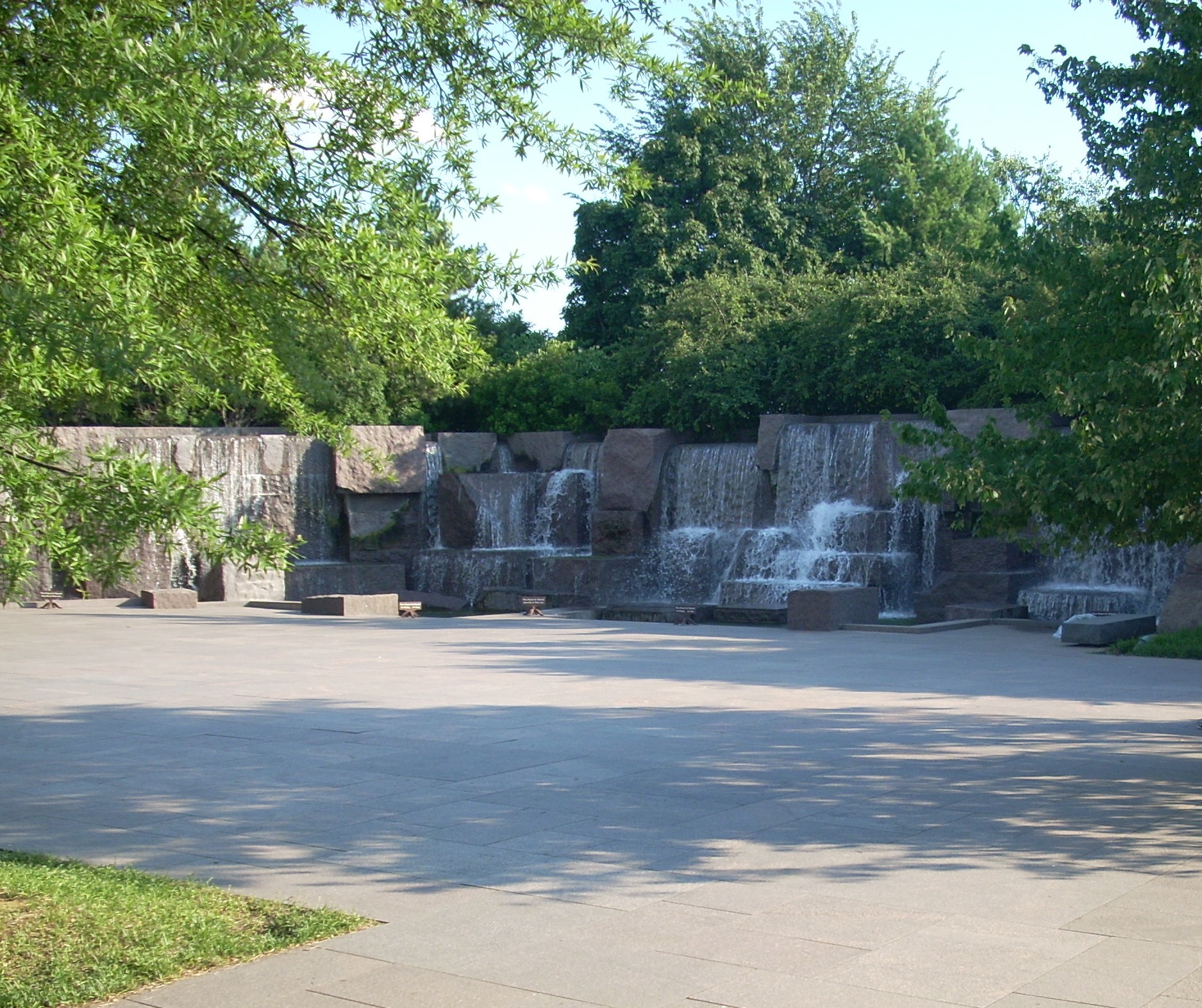 |
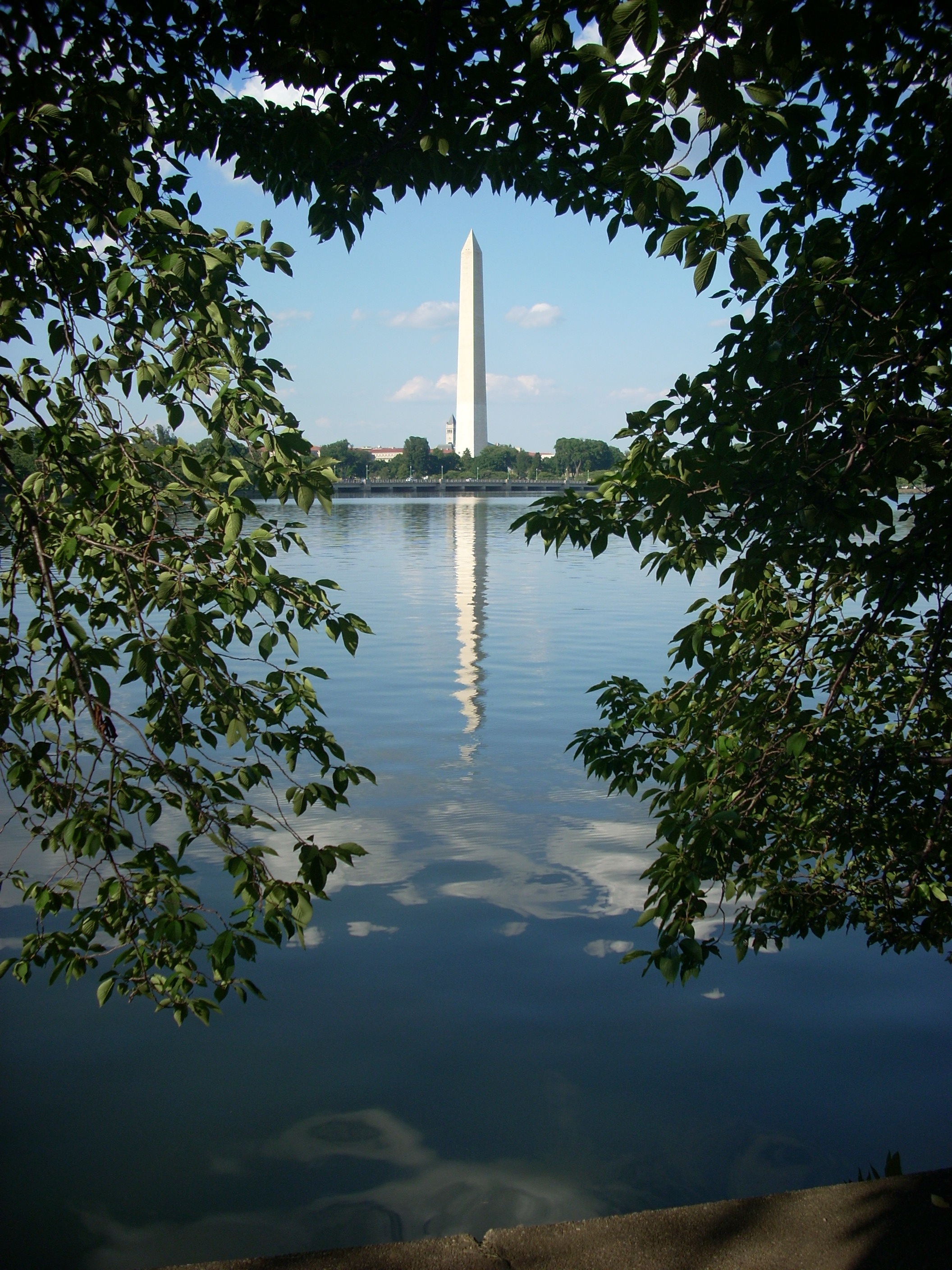 |
This stunning view of The Washington Monument is from the sidewalk near the FDR Memorial, across the Tidal Basin. Benches are available all along the trail and drinking fountains are provided at quarter mile intervals. Carts selling bottled water are run by vendors at the Lincoln and Jefferson ends of the trail and portapotties are available at both places. |
| The Jefferson Memorial is the final of the major memorials on the National Mall. This photo is taken from the bridge as you walk around the Tidal Basin from the Lincoln Memorial. This lake connects to the Potomac River under this bridge. The one mile walk from the Lincoln to Jefferson Memorial offers many benches where you might stop for a rest or a late lunch while looking out at sailboats, kayaks or rowing shells. The Jefferson Memorial honors Thomas Jefferson, our third president, and the intellectual foundation of America. The memorial was dedicated in 1947. Its design was adapted from one of Jefferson's own designs, that for the Rotunda at his University of Virginia. It is circular with pillars all around. A 19 foot statue of Jefferson stands inside, with his most famous writings engraved on the walls. The memorial forms a T with the White House, crossing the line of the national mall. The front steps of the Jefferson Memorial are the site of the National Easter Sunrise Service and the National Cherry Blossom Festival. Prior to the construction of the memorial, the city's most popular beach was here, and many people still swim here in hot weather. | 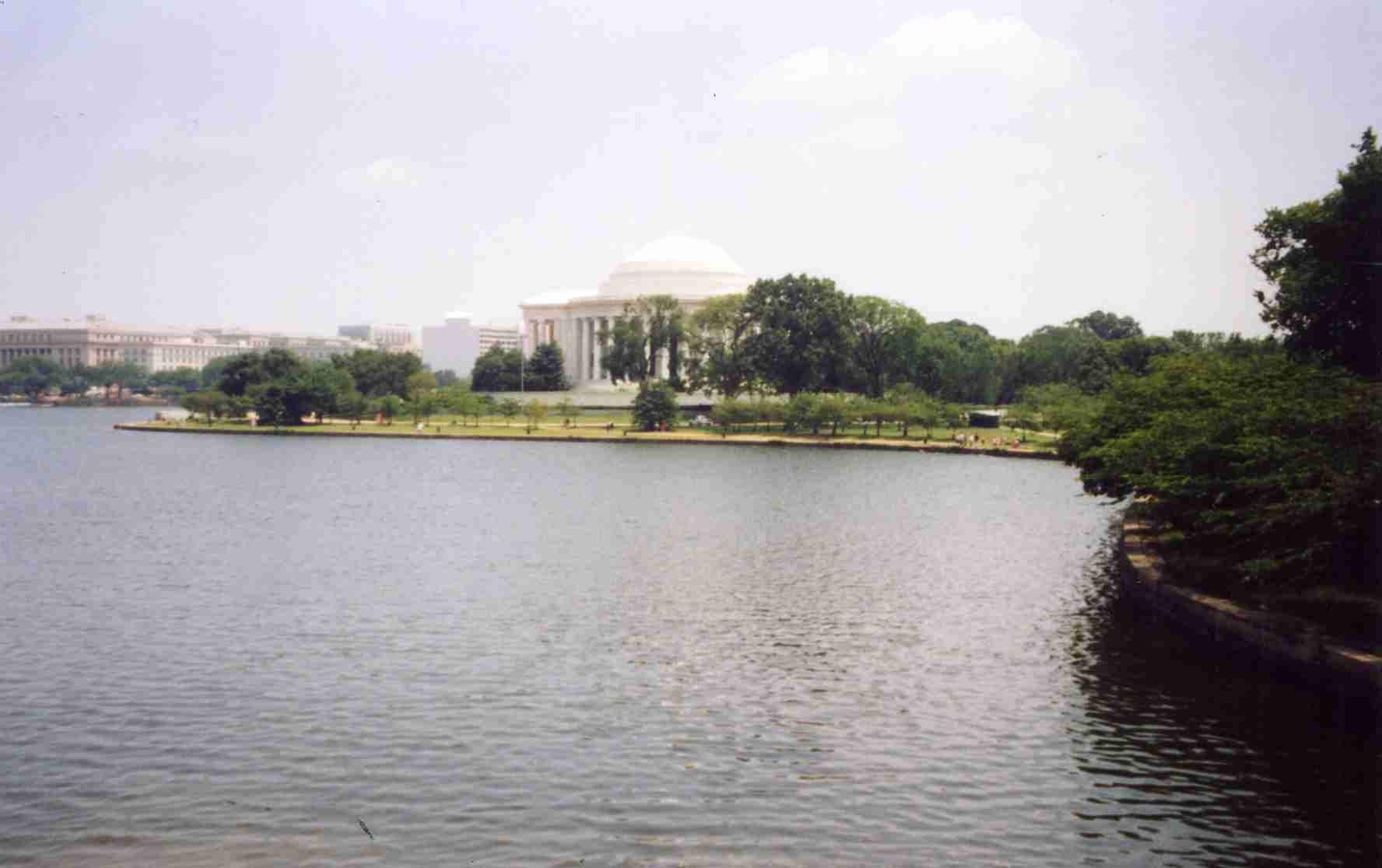 |
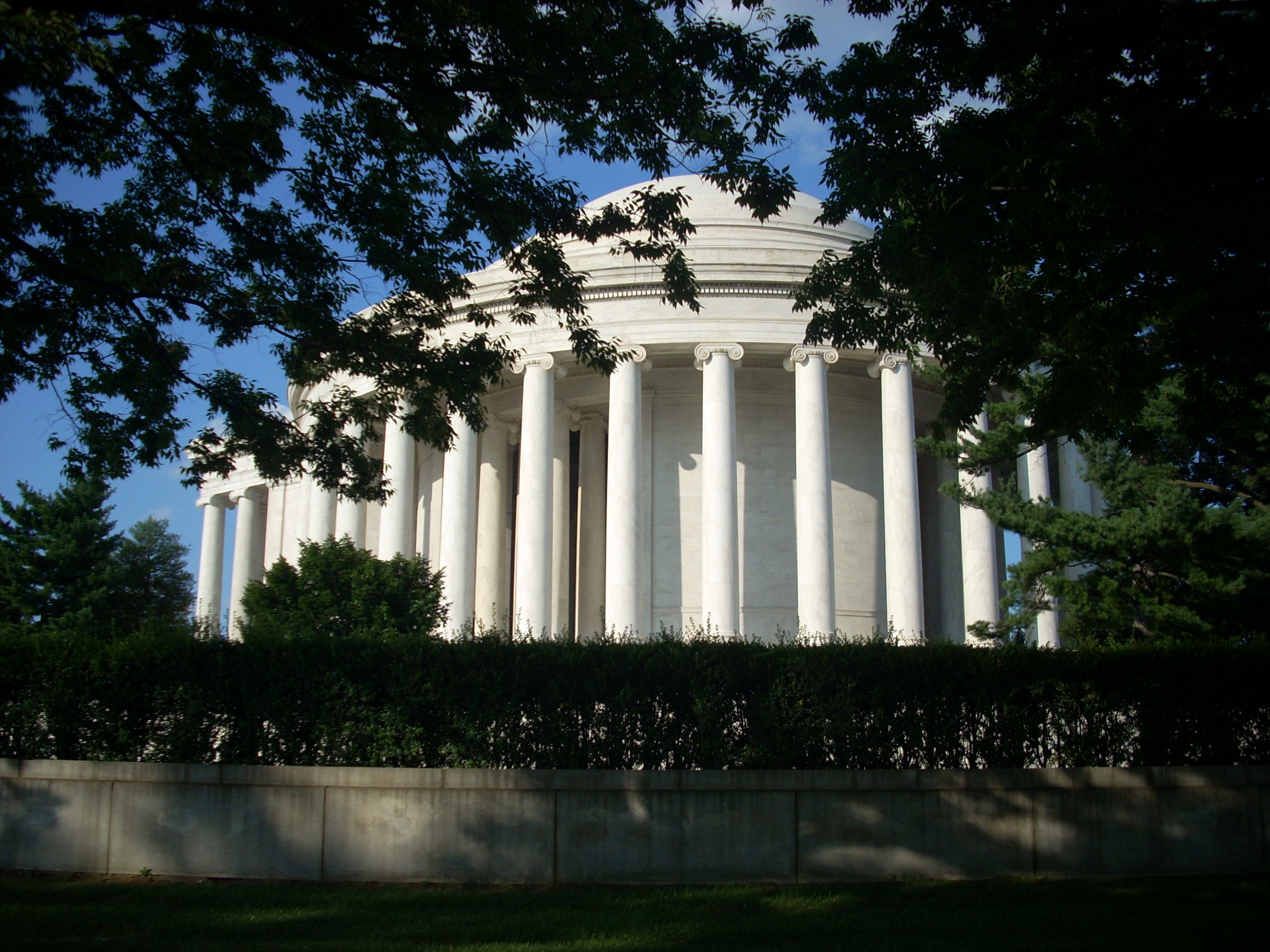 |
You can approach the Jefferson Memorial from several walkways, but this one through the trees is probably the most spectacular. The memorial itself is in solid condition right now, but after three decades of Congressional underfunding, the Tidal Basin itself is in need of restoration. The walkway, railings, benches and walls along the front of the Jefferson Memorial have all deteriorated due to water action, including freezing and thawing every Winter. Very few Americans realize the National Mall is actually a National Park. As a matter of fact, it is the most visited of the national parks. But with Congress under funding the National Park Service, they have unwittingly underfunded their own backyard. A movement is now underway to demand that Congress allocate the money to restore and protect these magnificant memorials and the grounds framing them. |
| Thomas Jefferson looks out from his inner sanctum inside the Jefferson Memorial. As we take this photo we are standing at the very edge of the Tidal Basin. As an architect himself, Jefferson would probably approve of his memorial, since modern architects consider it the most beautiful of all the memorials in Washington. One cannot visit the Washington Monument without feeling the sense of Majesty, or the Lincoln Memorial without the sense of Compassion, but time spent here imposes the sense of Genius. Of the Founding Fathers, all highly intelligent and well educated, Jefferson was surely the intellectual giant. Scientist, writer, engineer, botanist, philosopher, artist and musician, Jefferson was such a towering presence that we are only now, two centuries later, beginning to fully understand and appreciate his many facets. A bookstore in the basement here sells copies of his writings and some of the biographies written about him. | 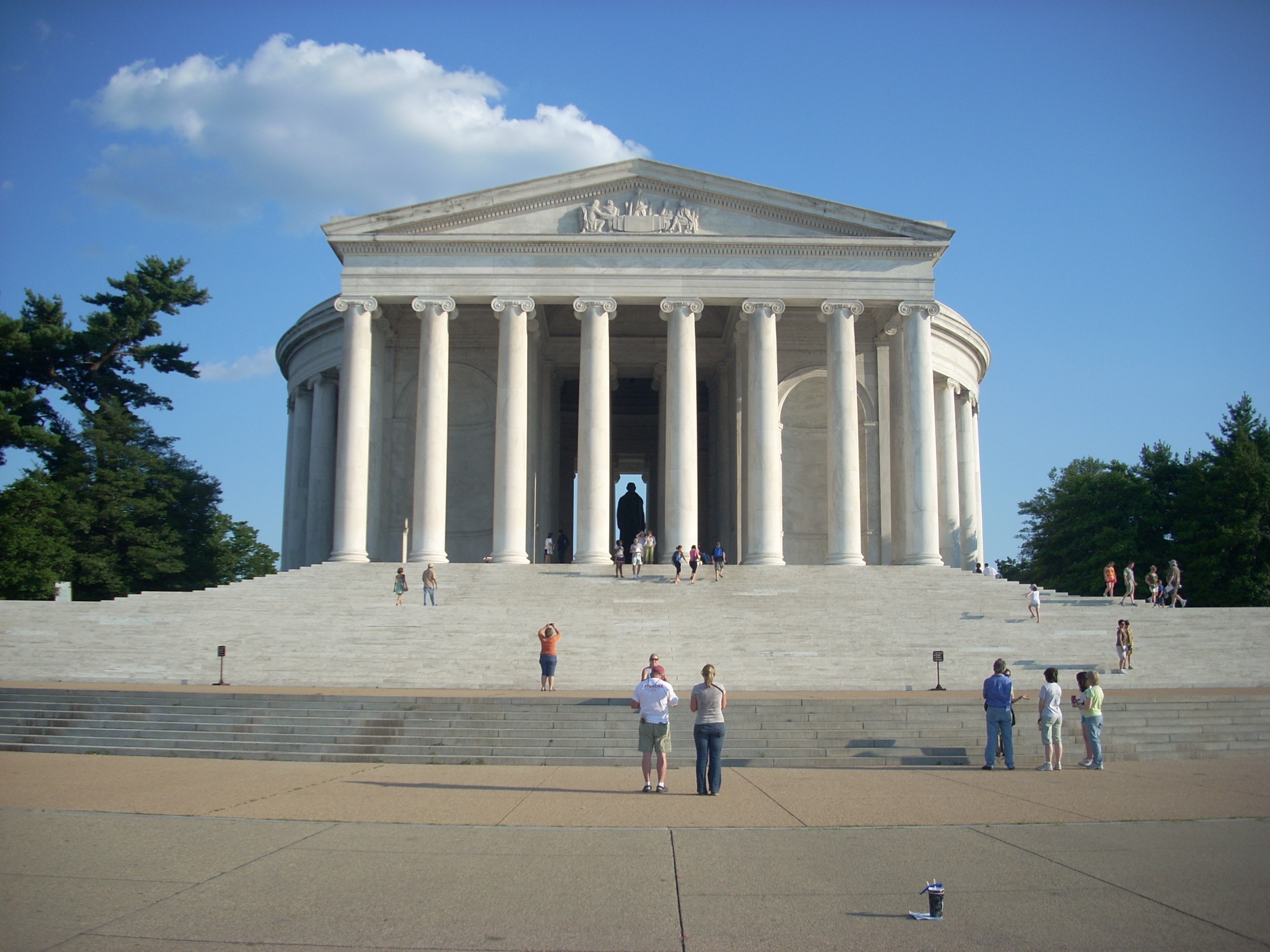 |
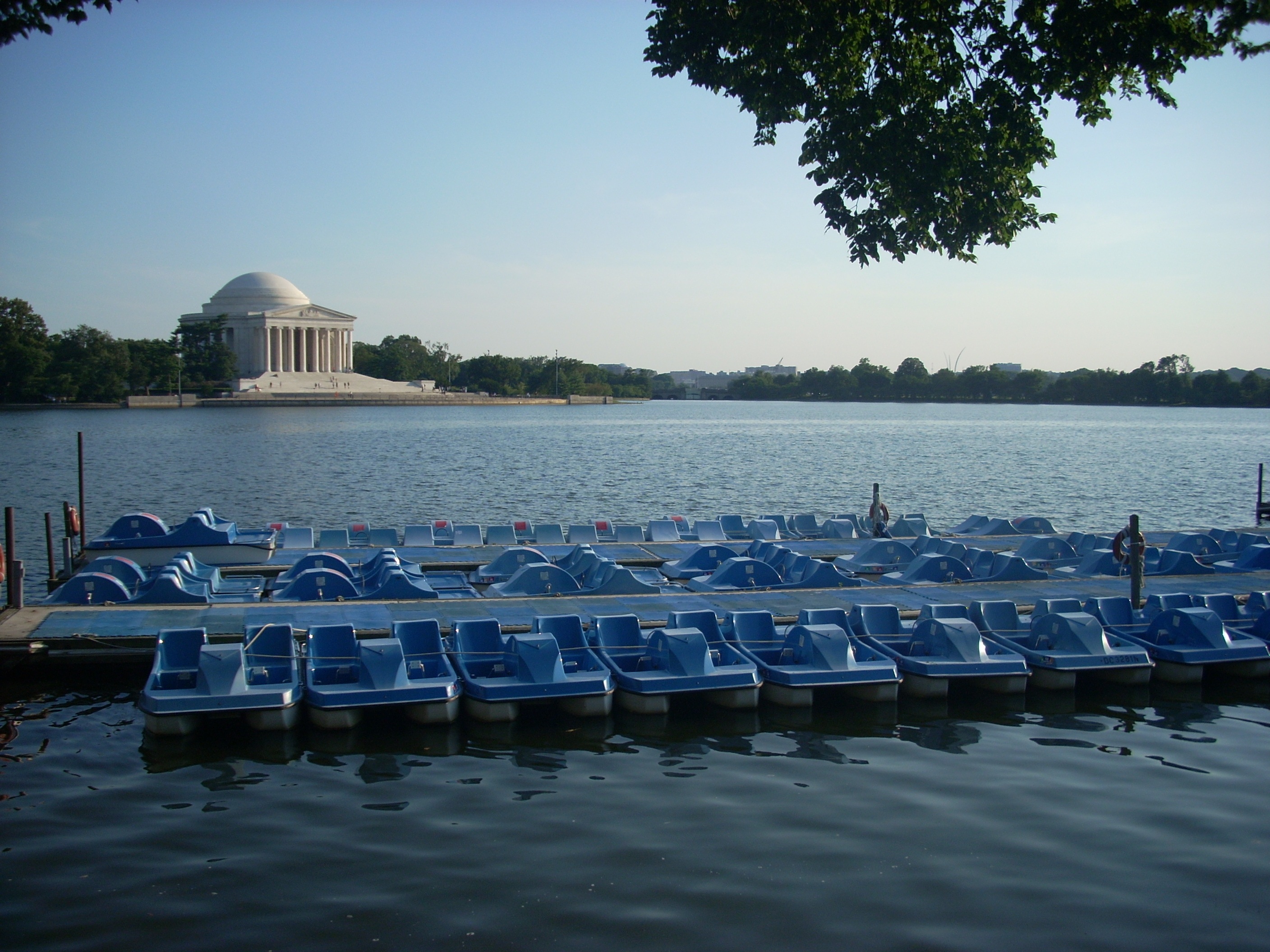 |
Paddleboats for Rent wait for customers along the Watergate Shore of the Tidal Basin. Directly behind us the hill climbs to the Washington Monument. To our left is the water gate allowing South Creek to flow into the Tidal Basin but, when the gate is raised, not allowing water to flow back up the creek when the Potomac is at flood stage and the basin water levels are rising. Also to our left is the Water Gate Apartment Building, famous (or infamous) from the 1970s scandal that ended the Richard Nixon presidency. If you're interested in that, go to the restaurant page of this section and study the second photo. To the left of the Jefferson Memorial is the Water Gate, and above and to its left is the Water Gate Apartment Building. Locals still fish along the shore of the tidal basin and the water is kept pure so the fish can safely be eaten. |
If you are staying at the Harrington, the last site along the National Mall that you will pass is this statue of Ben Franklin. Suitably enough, it is in front of his beloved Old Post Office, yet another of the many institutions he founded. Franklin may have been Jefferson's intellectual equal but was older and spent so much time in Europe he was perhaps not as appreciated here. The French always considered him the Ultimate American and various other European nations held Franklin in the highest esteem. Jefferson's brilliance may have played the key role in founding the nation, but without Franklin it would have been short lived. It was his brilliant diplomacy that brought the French into the American Revolution as our ally. Without their help, we could never have outlasted or turned back the British. But while Jefferson was concerned with the broad philosophical foundations of a new nation, Franklin attended to its machinery. He founded the U. S. Patent Office, the University of Pennsylvania, the national system of public libraries, daily mail delivery, the fire department, and various other government agencies. He held over 30 patents, including invention of the lightning rod, bifocals, the Franklin stove, the odometer, the typewriter, the apple peeler and the cherry pitter. Because Franklin made a fortune as a publisher, he never accepted anything for his government service, including a decade as Postmaster General, beyond a dollar a year. His work in electricity is recognized as the foundation of that whole area of Physics and made possible the work of Edison and Tessler a full century later. Ben Franklin was the final and most perfect expression of Puritanism. He possessed all of the Puritan virtues with none of their flaws. This statue and his beautiful post office building are nice, but he deserves his own memorial over on the National Mall. |
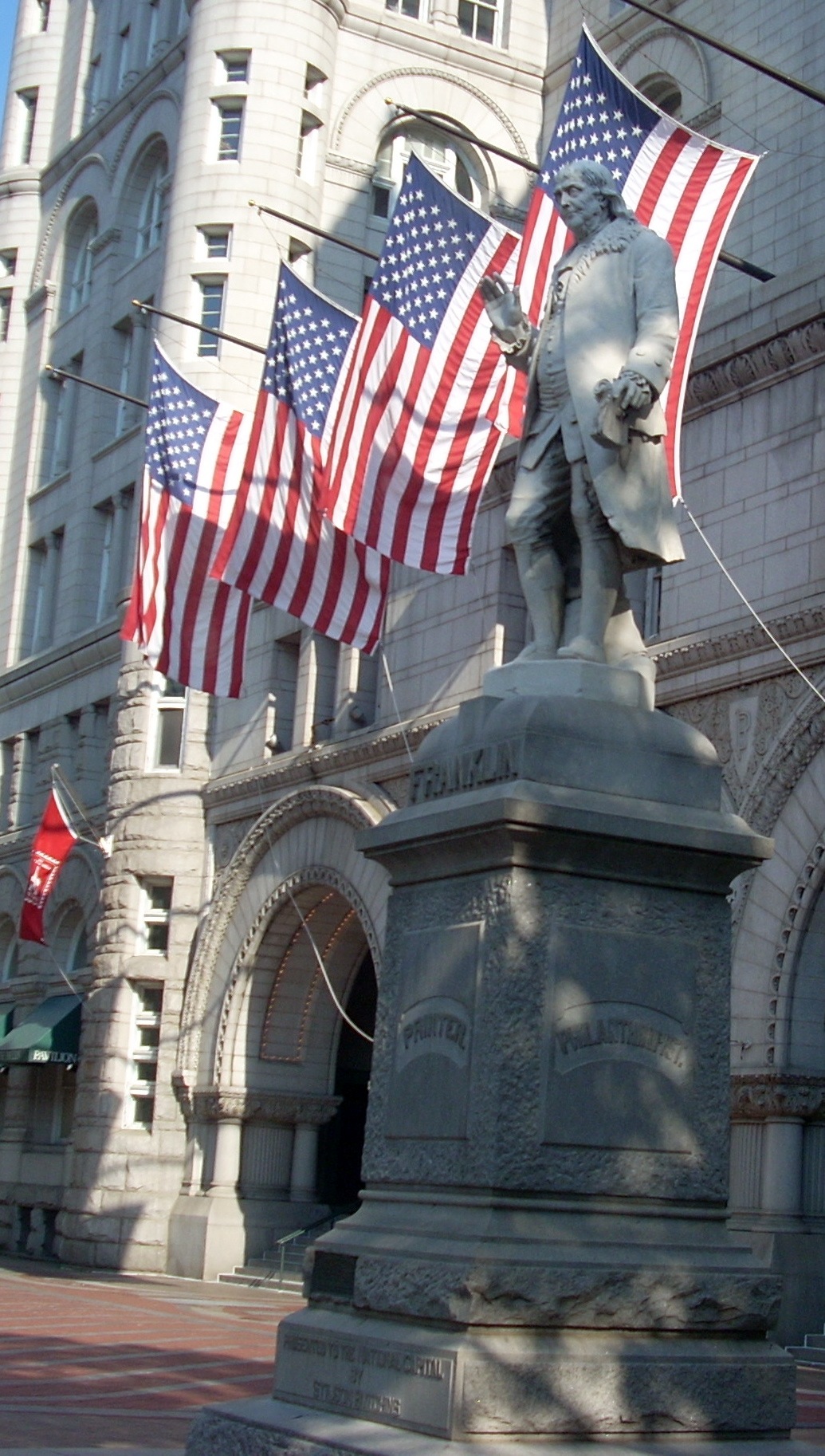 |
|
|||
|